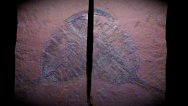 Description:
Only few select specialist collectors and scientists are aware
of this magnificent Beckwithia. It has been available for sale
since about 2006. However the asking price had been eight thousand
dollars. Quite a hefty price for this problematic specimen, now
substantially lowered. To the best of our knowledge, it is the
largest Beckwithia yet discovered. It is a positive and negative
specimen. The preservation is spectacular. It is fully 3D, has
good color and the body shows minute detail. Notice the pustulate
skin. The tail spine is fully displayed. Yes, obviously, there
is one big problem. The plate upon which the Beckwithia is found
was unfortunately sheared off at the quarry site. Somewhere in
that quarry, or on somones backyard patio paving stone, sits
forlornly, the left side of the cephalon. (Yes, the Week's quarry
produces patio and walkway paving stone!). Description:
Only few select specialist collectors and scientists are aware
of this magnificent Beckwithia. It has been available for sale
since about 2006. However the asking price had been eight thousand
dollars. Quite a hefty price for this problematic specimen, now
substantially lowered. To the best of our knowledge, it is the
largest Beckwithia yet discovered. It is a positive and negative
specimen. The preservation is spectacular. It is fully 3D, has
good color and the body shows minute detail. Notice the pustulate
skin. The tail spine is fully displayed. Yes, obviously, there
is one big problem. The plate upon which the Beckwithia is found
was unfortunately sheared off at the quarry site. Somewhere in
that quarry, or on somones backyard patio paving stone, sits
forlornly, the left side of the cephalon. (Yes, the Week's quarry
produces patio and walkway paving stone!).
The
Aglaspida (Aglaspids) are an unranked (incertae sedis) clade
of early arthropods that due to their resemblance to horseshoe
crabs were once believed to ancestral horseshoe crabs, and were
included with the chelicerata. Most recently, aglaspids are held
to be distinct group, possibly closely related trilobites, The
older idea that they link trilobites within Chelicerata is no
longer predominant. Although aglaspid fossils are distributed
worldwide, they are relatively
rare in the fossil record. They are, in fact, one of the
largest non-trilobite arthropod groups in the fossil record. Aglaspids
had 8 to 12 pairs of appendages and a prominent telson.
These morphological characteristics have caused considerable
support for Aglaspids being the maker of Protichnites ichnofossils.
Protichnites
of the Upper Cambrian Mount Simon Sandstone in Wisconsin have
been suggested as the first footprints on land in the fossil
record,
possibly marking the transition to terrestrial life that took
tens of millions years more to complete.
Please
excuse my poor photos. The true color is somewhere in between
the darker and lighter shots. |






